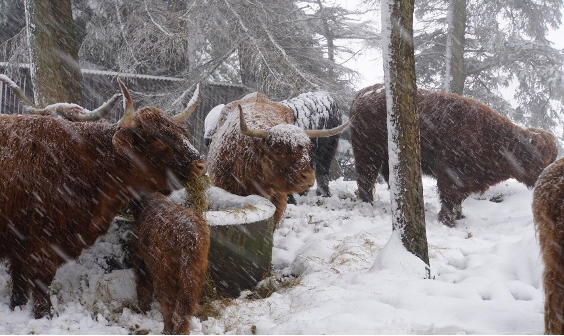Small scale production study in Shropshire
Not surprisingly, Highland Cattle were selected for a small Shropshire hill farm because their attributes fitted the type of grazing, land topography and the ability of the owners to start a farming enterprise on retirement.
Reilth Top lies at 1200ft and extends to 1400ft, with extremely thin highly acidic soils, which results in grass burning off in hot summers, and a steep bracken filled dingle or valley, providing shelter in winter but little grazing at any time of the year. The growing season is short. Also retired and new to farming, owners James and Jacky needed animals with calm temperaments and that were easy to handle. The animals also had to help retain the biodiversity on the farm to keep its High Level Stewardship status. There is 11 hectares in all.
The enterprise consists of four breeding cows and a bull with followers and 22 breeding Badger Face Welsh Mountain (Torddu) ewes with followers, plus a couple of bought in Gloucester Old Spot weaners in winter for outdoor rearing.
The essential traits for the cattle required are:
Hardiness to thrive outside in all weathers
Able to utilise poor grazing
Healthy
Easy calving outside with wide hips
Quiet temperaments and easy to handle
Excellent maternal traits
Produce good confirmation offspring
Exactly the same attributes are required from the ewes.
Objectives and markets
The objective at Reilth Top is to farm as organically as possible, using little or no pesticides, herbicides or wormers and raising beef and lamb on a grass/herbage-based diet as much as possible to produce healthy tasty beef, lamb and pork. Meat is sold ‘at the farm gate’ in beef and pork boxes and half lambs.
James and Jacky aim for the farm to make a small profit.
The market was built up slowly using electronic mail outs and word of mouth and encouraging visitors to see the farm, the animals, and the farming method used. They are fortunate to have an abattoir only 15 miles away and can therefore market low food miles as well as sustainability, biodiversity, traceability and healthy tasty products.
The cattle
The cows were initially AI’d but they now share a stock bull with a neighbouring farm. This soon results in more cattle than the land can handle. They have learnt to be ruthless and cull any cow or heifer that does not exhibit the traits required. This means culling any cows that hasn’t good maternal traits, a good temperament, or doesn’t produce good solid conformation animals for beef or for pedigree breeding. Male calves are all dehorned and castrated regardless of whether they would make a good pedigree bull, as having one bull on a small holding is enough. They aim to sell one or two cattle for beef per year and sell only good heifers in the pedigree market.
The same is true for the lambs which they aim to sell in late autumn/early winter so that they don’t have to carry them over the winter. They are only small lambs, but very sweet to eat.
In the lambs’ case though the boys are kept entire.
Both cattle and sheep calve and lamb outside whatever the weather.
Feeding regime
The cattle are kept out all year and in winter fed on haylage and high energy mineral licks when needed. As there is little pasture, all animals are offered minerals as they cannot range over extensive areas to find what they need. Unfortunately, it is a rare summer that the farm can also produce hay or haylage, so all fodder is bought in.
Cattle are only fed 16% cattle nuts when they come in for their TB tests or pre-shows when they are being halter trained. They are also trained to come to the bucket. This pasture fed policy makes the cattle slow growing as nature intended, so in the show ring they don’t look the part until they are three. They may go off for beef before 30 months, if they are big enough, or otherwise the cattle are left until they are more mature. Customers appreciate the natural rearing and healthy tasty meat,
The ewes are fed the same mix six weeks pre-lambing and a few weeks post-lambing until the grass is really growing.
For both, James and Jacky work on the principle that mothers milk is the best for all offspring. Calves and lambs are weaned naturally, minimising stress all round.
The economics
30-40 large bales of haylage are used throughout the year for an average of 12 head of cattle of all ages, 22 head of sheep and 30 odd lambs and two horses.
They sell beef, lamb and pork at Waitrose organic/farm shop type prices and pedigree heifers and ewe lambs at average pedigree sale prices. Taking heifers to an Oban sale from that far south would not be cost-effective.
Total income therefore varies per year but is roughly £11-12,000 per year.


